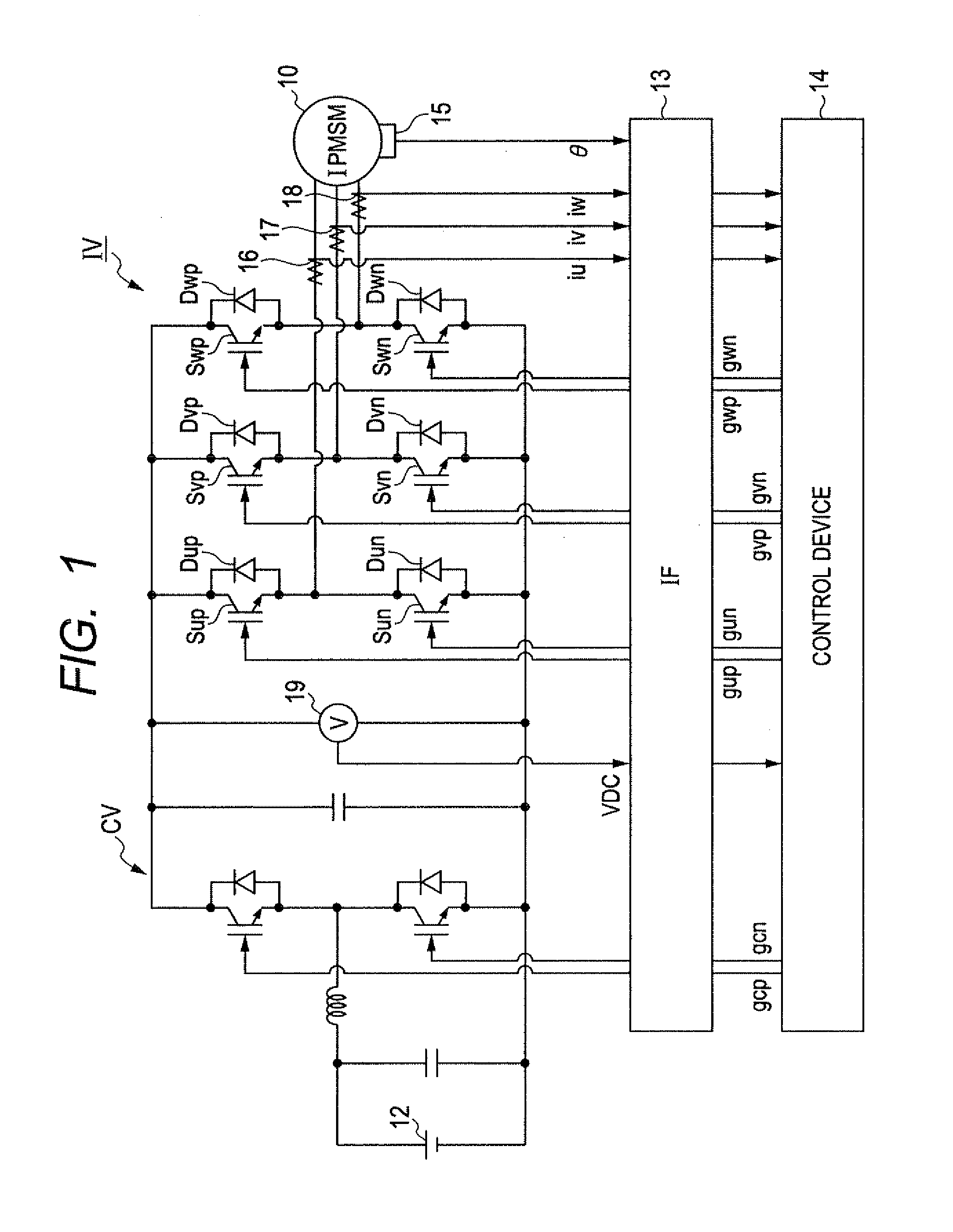Control apparatus for electric rotating machine
a control apparatus and electric rotating machine technology, applied in the direction of dynamo-electric converter control, motor/generator/converter stopper, dynamo-electric gear control, etc., can solve the problem of difficulty in controlling the output current at the command value in the overmodulation range in which the modulation index exceeds 1
- Summary
- Abstract
- Description
- Claims
- Application Information
AI Technical Summary
Benefits of technology
Problems solved by technology
Method used
Image
Examples
first embodiment
[0040]FIG. 1 is a diagram showing the overall structure of a control system for a motor-generator 10 mounted on a hybrid vehicle, the system including a control apparatus according to a first embodiment of the invention. The motor-generator 10 is a salient-pole type electric rotating machine which operates as a three-phase permanent magnet synchronous motor. That is, the motor-generator 10 is an IPMSM (Interior Permanent magnet Synchronous Motor).
[0041]The motor-generator 10 is connected to a high voltage battery 12 through an inverter IV and a step-up converter CV. The step-up converter CV steps up the output voltage of the high-voltage battery 12 (288 V, for example) up to a predetermined voltage (666 V, for example). The inverter IV is constituted of a series connection of switching elements Sup and Sun, a series connection of switching elements Svp and Svn, and a series connection of switching elements Swp and Swn, these series connections being connected to the U, V and W phase...
second embodiment
[0073]Next, a second embodiment of the invention is described with particular emphasis on the difference with the first embodiment.
[0074]In the second embodiment, a sub-feedback control is performed to control the current flowing through the motor-generator 10 at the command current set by the feedback control of the average value of, magnitude of the of the output voltage.
[0075]FIG. 5 is a functional block diagram explaining the process of model predictive control performed in this embodiment. In FIG. 5, the same reference numerals or characters identical to those shown in FIG. 3 represent the same components.
[0076]As shown in FIG. 5, a deviation calculating section 80 calculates the d-axis deviation Δid by subtracting the predicted current ide from the command current idr. A deviation calculating section 82 calculates the q-axis deviation Δiq by subtracting the predicted current iqe from the command current iqr. A deviation norm calculating section 84 receives the d-axis deviation...
third embodiment
[0081]Next, a third embodiment of the invention is described with particular emphasis on the difference with the first embodiment.
[0082]In the third embodiment, sub-feedback control is performed by use of a proportional element and an integral element to control the current flowing through the motor-generator 10 at the command current set by the feedback control of the average value of magnitude of the output voltage.
[0083]FIG. 6 is a functional block diagram explaining the process of model predictive control performed in this embodiment. In FIG. 6, the same reference numerals or characters identical to those shown in FIG. 3 represent the same components.
[0084]As shown in FIG. 6, the difference between the average voltage vector norm Ne and the norm target value Nr is multiplied by the integral gain Ki2 at an integral gain setting section 90. The output of the deviation norm calculating section 84 is multiplied by the integral gain Ki1 at an integral gain setting section 92. The out...
PUM
 Login to View More
Login to View More Abstract
Description
Claims
Application Information
 Login to View More
Login to View More - R&D
- Intellectual Property
- Life Sciences
- Materials
- Tech Scout
- Unparalleled Data Quality
- Higher Quality Content
- 60% Fewer Hallucinations
Browse by: Latest US Patents, China's latest patents, Technical Efficacy Thesaurus, Application Domain, Technology Topic, Popular Technical Reports.
© 2025 PatSnap. All rights reserved.Legal|Privacy policy|Modern Slavery Act Transparency Statement|Sitemap|About US| Contact US: help@patsnap.com



